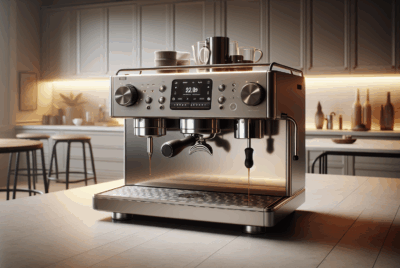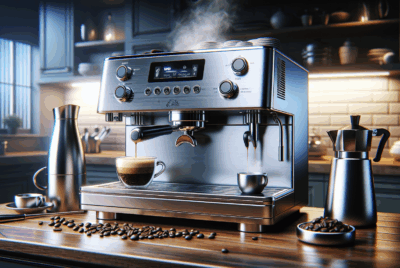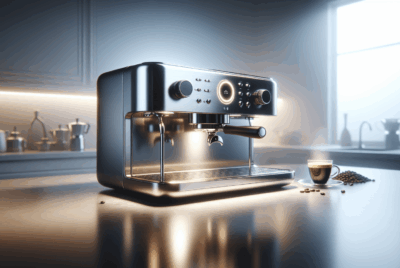Is an Espresso Machine Worth It: Evaluating the Investment
As an Amazon Associate, I earn from qualifying purchases, at no additional cost to you. Disclaimer
Every morning, I find myself reaching for that rich, aromatic shot of espresso to kickstart my day. With an espresso machine at home, I don’t have to queue at a café to get my caffeine fix.
An espresso machine can be a wise investment for those who value convenience and the quality of their coffee.

Having tried various options, I discovered that quality machines can replicate the café experience right in my kitchen.
Espresso machines vary in complexity and price, but the satisfaction of mastering the art of pulling a perfect espresso shot cannot be overstated.
For those who appreciate the nuances of coffee, an espresso machine opens up a new world of flavors and brewing techniques. It’s not just about saving money; it’s about experiencing the rich, bold taste of a freshly made espresso whenever I want.
Evaluating the Worth of an Espresso Machine
When deciding if an espresso machine is worth it, it’s key to look at its performance compared to other coffee makers, understand the various types available, consider the price range, and think about the long-term investment.
Comparison to Other Coffee Makers
I find that espresso machines differ quite a bit from regular coffee makers. With a drip coffee maker, you get a straightforward brew that’s easy and quick.
Espresso machines, on the other hand, let me enjoy a variety of espresso-based drinks like lattes and cappuccinos.
Espresso machines also provide a richer and more concentrated flavor. Though they usually cost more, the taste and variety can be worth it.
Comparing costs upfront, drip coffee makers are cheaper, but the satisfaction of a well-brewed espresso is unmatched.
Understanding Types of Espresso Machines
There are several types of espresso machines I look at to fit different needs and budgets.
Manual machines require more skill and time, but they offer great control over each step. Semi-automatic machines are popular for balancing control and convenience.
Automatic and super-automatic machines handle more processes, ensuring consistency. For those starting, entry-level machines are an affordable way to dip into espresso making. High-end machines offer professional-quality drinks at home.
The Role of Price Point and Budget
Espresso machines range from budget-friendly models to expensive, high-end ones. When I consider buying one, it’s crucial to match my budget with the machine’s features and build quality.
Cheap machines might save money initially but could lack durability.
Expensive machines often come with advanced features and better build quality. It’s important to weigh the potential cost savings over time against the initial investment. Entry-level machines are typically less costly, making them a good starting point for beginners.
Calculating Long-Term Investments
I also have to think about the long-term investment. While the initial price can be high, owning an espresso machine could lead to cost savings by reducing coffee shop visits.
Cheap machines might have low initial costs, but maintenance and part replacements can add up.
Additionally, high-end machines might have higher maintenance costs but offer durability and fewer repairs. Ongoing expenses, like coffee and maintenance, are part of the decision too. Over time, the savings from making my own coffee might outweigh the initial investment.
Features and Convenience

When considering an espresso machine, it’s important to look at both the essential features for brewing quality espresso and the convenience factors. Understanding these elements helps decide if investing in a machine is worthwhile.
Essential Features for Quality Espresso
For making great espresso, temperature control and espresso extraction are crucial. Without precise temperature, espresso won’t taste right.
Many machines have built-in controls that keep the water at the right level. It’s important to check how the machine handles extraction, too.
Some have pre-infusion capabilities that make sure the coffee grounds are wet evenly. A good machine will have these features, which improve every cup.
Convenience and Ease of Use
Automatic and super-automatic espresso machines provide a lot of convenience. They often have preset functions that save me time and make brewing easy.
Features like a built-in grinder or a milk frother can add to the ease of use. These machines do most of the work for me. I can get a high-quality drink without much effort.
Controls are usually user-friendly, with simple buttons or touch screens. This means I don’t need to be an expert to enjoy good espresso.
Machine Maintenance and Cleaning
Maintenance and cleaning are unavoidable but manageable with the right machine. Regular cleaning is important to keep it working well.
Many machines come with auto-cleaning features that make this simple. Descalers and filters help remove any buildup inside the machine.
Keeping an eye on the milk frother and the drip tray is also key. Some models alert me when parts need cleaning or replacing. This helps maintain quality and longevity.
Coffee Quality and Brewing Process

Choosing an espresso machine can affect the coffee quality and the way you brew coffee at home. Knowing how espresso extraction works can impact the results. The type and quality of coffee beans used are also vital.
Impact on Coffee Quality
When I brew espresso at home, I notice a big difference in the coffee quality compared to regular drip coffee. A good espresso machine extracts coffee oils that give a rich, complex flavor. Espresso has a thicker, creamier layer on top, called crema, which signals high-quality extraction.
The pressure applied during the brewing process influences the taste. Machines with stable pressure and temperature control help me achieve consistent results. With practice, I get a quality espresso that’s similar to what I find in coffee shops. Investing time to learn the machine can make a difference in enjoying high-quality coffee at home.
Understanding the Brewing Process
The brewing process for espresso is unique and requires some precision. I use a coffee grinder to grind the coffee beans finely, as the grind size affects espresso quality. A good-quality grinder can make all the difference. Tamping is another step, where I use a coffee tamper to press the coffee evenly and firmly. This is crucial for even extraction.
I pay attention to the espresso extraction time. It usually takes around 25 to 30 seconds. If it’s too fast, the coffee may taste sour; too slow, and it might end up bitter. With some practice and adjustment, getting the brewing process right can lead to good espresso.
The Importance of Coffee Beans
The coffee beans I choose are a key factor in the end product. Selecting high-quality beans makes a noticeable impact. Often, I find fresh beans from local roasters provide the best flavor. High-quality coffee beans offer unique flavors and aromas that improve the overall drinking experience.
I also care about how the beans are stored. Keeping them in an airtight container helps retain their freshness. Using fresh, high-quality beans combined with good brewing skills gives me a better chance to enjoy quality coffee at home. With the right machine and beans, brewing becomes more rewarding.
Personal Considerations

When deciding if an espresso machine fits into my life, I need to weigh how often I drink coffee and my willingness to learn new skills. It’s important to think about daily routines and the type of coffee I enjoy.
Lifestyle and Coffee Consumption Habits
I first think about how often I drink coffee and what kind of drinks I like. If I enjoy lattes or cappuccinos regularly, an espresso machine could be a wise choice. It allows me to make my favorite espresso-based drinks at home without going to a café.
When I make these drinks at home, it could save me both time and money if I’m someone who often buys coffee. Regular coffee drinkers will likely find this especially beneficial. I also have to consider the space in my kitchen. The espresso machine needs room, which means I must be willing to make space for it.
Learning Curve and Barista Skills
Getting an espresso machine involves learning how to make barista-quality drinks. There is a learning curve, as I need to understand how the machine works. Practicing can be fun, but it takes some patience to make the perfect cup.
Gaining barista skills includes tasks like gauging grounds, tamping, and steaming milk. If I enjoy mastering new skills, this process can be part of the appeal. With time, I can adjust techniques to suit my taste, which brings a personal touch to every cup.
Recommendations and Conclusions

When deciding if an espresso machine is worth it, I consider my coffee habits and preferences. If I enjoy high-quality espresso often, a home espresso machine might be a smart choice. It can offer convenience and control over the brewing process.
The average cost of a home espresso machine varies widely. Entry-level models start around $100, while high-end ones can be $1,000 or more. Investing in the best machines adds value over time, especially for regular coffee drinkers.
I also think about the water quality in my area. Hard water can affect machine performance and taste. Using filtered water or descaling regularly helps maintain the machine’s function.
Here’s a simple list to help decide:
- Frequency: How often do I drink espresso?
- Budget: What am I willing to spend?
- Space: Do I have enough room for the machine?
- Maintenance: Am I ready for regular cleaning?
If I enjoy both espresso and coffee, some machines offer dual functions. This can save space and provide flexibility.
Choosing the best espresso machine depends on my personal needs. Researching models, reading reviews, and considering the points above guides my decision.
Frequently Asked Questions
I often wonder if an espresso machine truly enhances the coffee experience. Many factors come into play, including cost, taste, and convenience.
What are the benefits of owning an espresso machine?
Owning an espresso machine offers the convenience of making espresso anytime. It allows me to experiment with different types of espresso drinks, like lattes and cappuccinos, right at home.
Can you make regular coffee with an espresso machine?
Yes, I can make regular coffee with some espresso machines. Using the right settings or accessories, I can brew coffee that resembles drip-style coffee. However, it’s not quite the same as traditional coffee brewed in a standard maker.
How does the cost of an espresso machine compare to its value over time?
While the initial cost can be high, I find that making coffee at home often saves money compared to buying it from a café every day. Over time, the savings can offset the machine’s cost.
What should I consider when deciding between an espresso machine and a regular coffee maker?
I look at how much coffee I drink daily and the types of drinks I like.
Espresso machines are great for making café-style drinks, while regular coffee makers are ideal for brewing larger quantities of standard coffee.
Do more expensive espresso machines produce better coffee?
Not always. While price can reflect quality, many affordable models produce excellent espresso. I’ve learned that technique and quality of coffee beans often make a bigger difference.
How is espresso different from standard drip coffee?
Espresso is made by forcing hot water through finely-ground coffee, resulting in a more concentrated, stronger flavor.
Drip coffee, on the other hand, involves pouring water over coffee grounds, creating a milder and larger cup.



